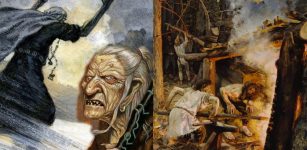Strange Prophecy Of Oleg Of Novgorod’s Death – Where Is Russia’s Viking Ruler Buried?
Ellen Lloyd - AncientPages.com - When a strange prophecy is fulfilled, we can either call it a coincidence or simply say we believe it’s possible to predict future events.
Coincidences do happen. We all know that, but the puzzling death of Russia’s first Viking ruler Oleg Of Novgorod seems to show it’s impossible to avoid fate, no matter how much one tries.
Mystery surrounds Oleg Of Novgorod’s burial place, and how he ended his life is still a puzzle.
Left: Painting of Oleg of Novgorod. Credit: Public Domain - Right: A pagan priest tells Oleg his prophecy. Image source
Who Was Russia’s Viking Ruler Oleg Of Novgorod?
Nicknamed Oleg the Prophet, Oleg Of Novgorod was a Viking ruler in Russia who laid the foundation of the powerful state of Kievan Rus that from the late 9th to the mid-13th century was under the reign of the Varangian Rurik dynasty. It’s uncertain when Oleg of Novgorod was born but it was most likely in 845, and he was a relative of the legendary King Rurik whose followers likely originated in Scandinavia and were related to Norse Vikings.
King Rurik remained in power until his death in 879, and he was succeeded not by his son Igor, a minor then, but by Oleg. The family relationship between Rurik and Oleg is not entirely clear. Some historians maintain Oleg was Rurik’s oldest brother while others say he was his brother-in-law. In any case, Oleg and Rurik shared family ties that we do know for certain.
When Oleg came to power, he launched several attacks on foreign lands. He attacked Constantinople, the capital of the Byzantine Empire on at least one occasion.
Leading an army composed of Variagi, Slavs, and Finns he marched to the south, received the submission of Smolensk and Lubetch, and arrived under the walls of Kiev. He successfully “subdued the Novgorodians, the Krivitchi, the Meria, the Drevliané, the Severiané, the Poliané, the Radimitchi, and thus united nearly all the Russian tribes under his sceptre.
Oleg being mourned by his warriors. Painting by Viktor Vasnetsov, 1899. Credit: Public Domain
In nine hundred and seven Oleg collected a large army from among the tributary races, equipped two thousand boats, and prepared to invade Tsargrad by land and sea. Russian legends have embellished this expedition with many wonderful details.
Oleg built wheels to his vessels, and spread their sails; blown by the wind, they reached the gates of the city. Leo the Sixth, the Philosopher, in fright, agreed to pay tribute, but the Greeks tried to get rid of the Russians by offering them poisoned food. Oleg divined their perfidy.
He imposed a heavy contribution, a commercial treaty advantageous to the Russians, and suspended his shield on the Golden Door.
To his subjects, Oleg was more than a hero.
Terror-stricken by his wisdom, these “foolish and idolatrous people” looked on him as a sorcerer. In the Scandinavian sagas we find many instances of chiefs, such as Odin, Gylf, and Raude, being at the same time great warriors and great magicians.” 1
The Prophecy Of Oleg Of Novgorod
It is said that one day Oleg of Novgorod encountered pagan priests who foretold his death. Other legends tell he learned about the prophecy from a magician. According to the prophecy, Oleg of Novgorod was going to be killed by his stallion.
Painting by V. M. Vasnetsov. Credit: Public Domain
To escape fate, Oleg of Novgorod sent away his favorite horse. Years passed, to be on the safe side he even avoided riding. Then, one day he learned his horse had died and he insisted on being taken to the place where the animal’s bones lay. Being perfectly certain the prophecy couldn’t be fulfilled anymore; Oleg of Novgorod tapped the skull of the horse with his boot. When he did this, a snake slithered from the skull and bit him. Oleg died, thus fulfilling the prophecy.
There are other legends surrounding the death of Oleg, but this one is the most well-known.
Where Is Oleg Of Novgorod Buried?
Truth be told, the burial place of Oleg of Novgorod has never been found. Being a Viking, he was most likely put to rest in a burial mound.
The reputed burial mound for Oleg of Novgorod; Volkhov River near Staraya Ladoga. Credit: Wilson44691 -Public Domain
According to Viking funeral traditions, a Viking chief could be either burned or buried. A great Viking warrior received a ship burial, but in the case of Oleg of Novgorod, historians suspect he was buried in a mound. The trouble is we have no idea which mound may contain his remains. One proposed candidate is a burial mound is along the Volkhov River near Old Ladoga, Russia. It does closely resemble other Viking burial mounds found across Scandinavia.
However, when scientists excavated the site in 1823, they found only an old spearhead and no remains of Oleg of Novgorod. Some have suggested the great Russian Viking ruler may be buried in the vicinity of Kiev, but this burial place has not been found so far.
Written by Ellen Lloyd – AncientPages.com
Copyright © AncientPages.com All rights reserved. This material may not be published, broadcast, rewritten or redistributed in whole or part without the express written permission of AncientPages.com
Expand for referencesMore From Ancient Pages
-
 Grinding Stone Sheds New Light On The Diet Of Early Neolithic Farmers In Scandinavia
Archaeology | Dec 30, 2024
Grinding Stone Sheds New Light On The Diet Of Early Neolithic Farmers In Scandinavia
Archaeology | Dec 30, 2024 -
 Ancient Roman Laws Give Us A Window Into A World Of Abuse
Featured Stories | May 24, 2022
Ancient Roman Laws Give Us A Window Into A World Of Abuse
Featured Stories | May 24, 2022 -
 200,000-Year-Old Grass Bed Discovered In South Africa’s Border Cave
Archaeology | Aug 14, 2020
200,000-Year-Old Grass Bed Discovered In South Africa’s Border Cave
Archaeology | Aug 14, 2020 -
 Death Of Norse God Balder And Loki’s Mischief That Led To Destruction In Ragnarok
Featured Stories | Nov 15, 2016
Death Of Norse God Balder And Loki’s Mischief That Led To Destruction In Ragnarok
Featured Stories | Nov 15, 2016 -
 Extremely Rare Fossils Of 160-Million-Year-Old Sea Spider And Its Diversity By The Jurassic
Fossils | Aug 22, 2023
Extremely Rare Fossils Of 160-Million-Year-Old Sea Spider And Its Diversity By The Jurassic
Fossils | Aug 22, 2023 -
 Amaru (Katari) – Powerful Inca God Who Controlled Weather Phenomena
Featured Stories | Apr 9, 2024
Amaru (Katari) – Powerful Inca God Who Controlled Weather Phenomena
Featured Stories | Apr 9, 2024 -
 Astronomically Aligned Temples And Pyramids Of Ancient World
Featured Stories | Dec 10, 2021
Astronomically Aligned Temples And Pyramids Of Ancient World
Featured Stories | Dec 10, 2021 -
 Paris Catacombs: Huge Underground Labyrinth Full Of Secrets
Featured Stories | Jan 3, 2016
Paris Catacombs: Huge Underground Labyrinth Full Of Secrets
Featured Stories | Jan 3, 2016 -
 Drought Accelerated Hittite Empire Collapse – New Study Suggests
Archaeology | Feb 12, 2023
Drought Accelerated Hittite Empire Collapse – New Study Suggests
Archaeology | Feb 12, 2023 -
 Silver Jewelry Buried In Leather Purse Discovered In Bulgaria
Archaeology | Apr 5, 2016
Silver Jewelry Buried In Leather Purse Discovered In Bulgaria
Archaeology | Apr 5, 2016 -
 Louhi – Witch Goddess Of The North And The Magical Artifact Sampo In Finnish Mythology
Featured Stories | Sep 21, 2017
Louhi – Witch Goddess Of The North And The Magical Artifact Sampo In Finnish Mythology
Featured Stories | Sep 21, 2017 -
 Rare Ancient Precious Artifacts Found In Rusovce, Slovakia
Artifacts | Sep 26, 2015
Rare Ancient Precious Artifacts Found In Rusovce, Slovakia
Artifacts | Sep 26, 2015 -
 Magical Adder Stone And Its Immense Power
Celtic Mythology | Jul 14, 2018
Magical Adder Stone And Its Immense Power
Celtic Mythology | Jul 14, 2018 -
 Maat – Ancient Egypt’s Most Important Religious Concept
Egyptian Mythology | Apr 4, 2018
Maat – Ancient Egypt’s Most Important Religious Concept
Egyptian Mythology | Apr 4, 2018 -
 Rare Eleventh-Century Astrolabe Unearthed Recently Sheds Light On Islamic-Jewish Scientific Exchange
Scripts, Paintings & Inscriptions | Mar 4, 2024
Rare Eleventh-Century Astrolabe Unearthed Recently Sheds Light On Islamic-Jewish Scientific Exchange
Scripts, Paintings & Inscriptions | Mar 4, 2024 -
 11 Ancient Submerged Canoes Found In Wisconsin’s Lake Mendota – Evidence Of A Lost Village?
Archaeology | May 27, 2024
11 Ancient Submerged Canoes Found In Wisconsin’s Lake Mendota – Evidence Of A Lost Village?
Archaeology | May 27, 2024 -
 Mysterious Steles Of Mongolia – ‘Deer Stones’ In The Tsatsyn Ereg Necropolis
Archaeology | Jan 23, 2019
Mysterious Steles Of Mongolia – ‘Deer Stones’ In The Tsatsyn Ereg Necropolis
Archaeology | Jan 23, 2019 -
 Never-Before-Seen 16 Meters Long Ancient Egyptian Papyrus Unveiled To The Public
Artifacts | Feb 21, 2023
Never-Before-Seen 16 Meters Long Ancient Egyptian Papyrus Unveiled To The Public
Artifacts | Feb 21, 2023 -
 Colossi Of Memnon Guarded Temple Of Pharaoh Amenhotep III And Curious Sound Phenomenon
Featured Stories | Feb 2, 2021
Colossi Of Memnon Guarded Temple Of Pharaoh Amenhotep III And Curious Sound Phenomenon
Featured Stories | Feb 2, 2021 -
 Mystery Of Europe’s Bog Body Phenomenon Solved By Scientists
Archaeology | Jan 12, 2023
Mystery Of Europe’s Bog Body Phenomenon Solved By Scientists
Archaeology | Jan 12, 2023




